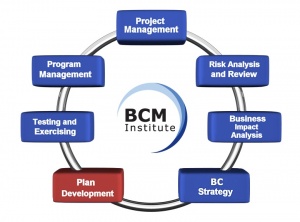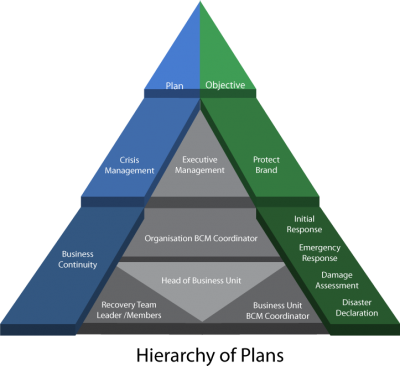Difference between revisions of "Damage Assessment"
| (One intermediate revision by one other user not shown) | |||
| Line 2: | Line 2: | ||
|- | |- | ||
| '''1.''' Damage Assessment or DA is the [[Process|process]] of assessing the financial and non-financial damage after a [[Disruption|disruption]] has occurred. | | '''1.''' Damage Assessment or DA is the [[Process|process]] of assessing the financial and non-financial damage after a [[Disruption|disruption]] has occurred. | ||
| + | {{Template:BL-BCM-5Banner}} | ||
'''Note''': This assessment includes damage to physical assets, for example facilities, [[Vital_Records|vital records]] and equipment, to determine what can be salvaged or [[Restore|restored]] and what must be replaced. | '''Note''': This assessment includes damage to physical assets, for example facilities, [[Vital_Records|vital records]] and equipment, to determine what can be salvaged or [[Restore|restored]] and what must be replaced. | ||
| − | + | {{Template:BCM Course}}{{BcmBoK 5 CL 2B}}<br/> <br/> {{BcmBoK 5 CL 2C}}<br/> <br/> {{BcmBoK 5 CL 2CC}}<br/> <br/> {{BcmBoK 5 CL 2D}} | |
| − | {{BcmBoK 5 CL 2B}}<br/> <br/> {{BcmBoK 5 CL 2C}}<br/> <br/> {{BcmBoK 5 CL 2CC}}<br/> <br/> {{BcmBoK 5 CL 2D}} | ||
<br><br> | <br><br> | ||
| − | {{Template:BLCoursesBanner}} | + | {{Template:BLCoursesBanner}} |
| − | |||
| − | |||
| − | |||
{{Bcm Institute Source}} | {{Bcm Institute Source}} | ||
|} | |} | ||
| − | + | [[Image:3D BCM Series Plan Development.jpg|thumb|left|140px|Implementing Your Business Continuity Plan [https://www.bcm-institute.org/product/implementing-your-business-continuity-plan-second-edition/ BUY!]]] | |
[[File:BCM Planning Methodology PD.jpg|right|300px|BCM Planning Methodology:Plan Development]] | [[File:BCM Planning Methodology PD.jpg|right|300px|BCM Planning Methodology:Plan Development]] | ||
Latest revision as of 09:04, 28 October 2020
| 1. Damage Assessment or DA is the process of assessing the financial and non-financial damage after a disruption has occurred.
Note: This assessment includes damage to physical assets, for example facilities, vital records and equipment, to determine what can be salvaged or restored and what must be replaced.
| |||||||||||||||||||||||||||||

2. The process of assessing the financial/non-financial damage following a Business Continuity E/I/C. It usually refers to the assessment of damage to physical assets e.g. vital records, buildings, sites, technology to determine what can be salvaged or restored and what must be replaced.
(Source: Business Continuity Institute - BCI)
3. The process used to appraise or determine the number of injuries and human loss, damage to public and private property, and the status of key facilities and services resulting from a natural or human-caused disaster or emergency.
(Source: ASIS International - ASIS International)
4. An appraisal or determination of the effects of disaster on human,physical,economic and natural resources.
(Source: NFPA 1600 Standard on Disaster/Emergency Management and Business Continuity Programs, NFPA 1600:2007)
5. The process of evaluating the severity and consequences of an incident and communicating the results.
(Source: NFPA 1600 Standard on Disaster/Emergency Management and Business Continuity Programs, NFPA 1600:2007)



